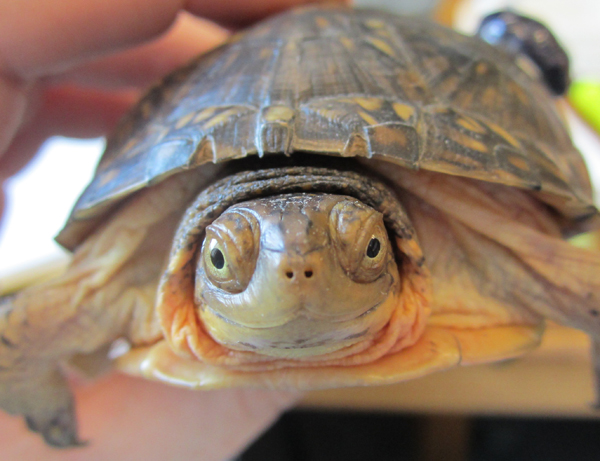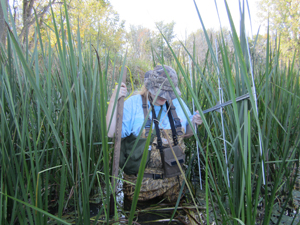UM-Flint Biologists Track the Blanding's Turtle

Angela Cleary always wanted to work with animals. One of her dreams was to be a veterinarian. Today she is a full-time UM-Flint student working on a master's degree in biology, and living her dream of working with wild animals—including her favorite turtles.
Cleary is working on important research that involves the Detroit Zoological Society (DZS), the Shiawassee National Wildlife Refuge in Saginaw County, and a dozen young Blanding's turtles.
"The Blanding's turtle is listed as a species of 'special concern' in Michigan," said Cleary. "In some other states, it's on their endangered species list."
"One of the main predators of the turtles' eggs is the raccoon," DZS Curator of Reptiles Jeff Jundt said. "Because turtle eggs are a favorite food of raccoons, more than a hundred eggs were removed from the refuge in 2011, and sent to a company called Herpetological Resource and Management (HRM) to be hatched."
Through a process called headstarting, about 60 of the hatchlings were transported to the Zoo. The turtles can grow quickly in captivity. For the project, 12 turtles were selected, and small transmitters were affixed to their shells.
The turtles were returned to the wildlife refuge, and released in one area. According to Cleary, very little is known about the juvenile Blanding's turtle. She and her team of three UM-Flint undergraduate students are closely monitoring the turtles using electronic tracking devices.

"Attaching transmitters to one-year old headstarted Blanding's turtles is something few researchers have done. It is a great opportunity for Angie to be working on this cutting edge research," according to Teresa Yoder-Nowak, a lecturer in the Biology Department. "The data Angie collects will provide valuable information on the conservation and management of young Blanding's Turtles, an age class we currently know very little about for this species."
Because of the hot summer, the research did not begin until late August. Since then, the turtle team monitors the movements of the young turtles twice each week. Periodically, the turtles are caught, weighed, and measured.
"The refuge is trying to put together the pieces of the puzzle to enable us to conserve our Blanding's turtle population," noted Steve Kahl, Refuge Manager, Shiawassee National Wildlife Refuge. "Angie's study on the habits of juvenile turtles here is a critical piece."
When completed, the research will give wildlife scientists more information on the turtles' habitat, range of travel, and growth rate.
According to Biology Lecturer Ernie Szuch, the research project is an example of "good networking in action." "This project is really a great example of various agencies cooperating to achieve a common goal," said Szuch. "We knew of the headstarting program for Blanding's turtles through David Mifsud of HRM, and informed him that we had a graduate student that was very interested in Blanding's turtles. Things just happened from there."
Tracking will continue at the wildlife refuge until the turtles go into hibernation. Cleary will continue again next spring. Plans call for eventually releasing the remaining turtles at the DZS back into the refuge.
The Blanding's turtle can be identified with its high-domed back and yellow underside. They can live to be 50-60 years old.
"To manage the Blanding's turtle we need to understand it, and right now there's a lot of information missing," said Cleary. "I want to help better understand the species, and bring the numbers back."
The Wildlife Refuge is a popular destination for researchers. At any given time, researchers from various state universities will be working on projects. The refuge also plays host to researchers from universities across the country.
Related Posts
No related photos.
UM-Flint News
The Office of Marketing & Communications can be reached at mac-flint@umich.edu.